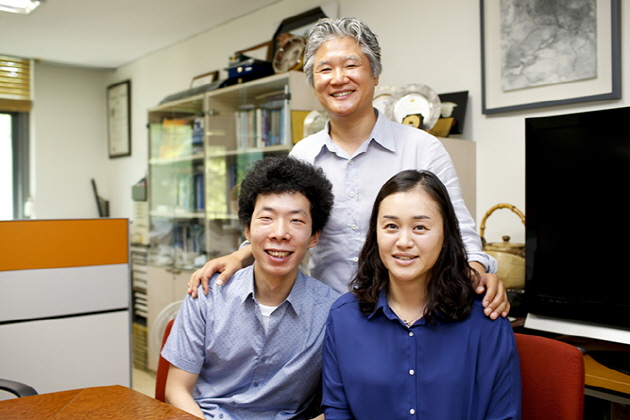Professor Park Yong-wan's team wins 'Best Poster Paper Award' in the 11th International Conference on Information Technology-New Generation(ITNG 2014), held in Las Vegas, USA.
The team proposes 'a new conceptual path generation technology for unmanned automobile' to avoid obstacles.
[July 2, 2014]

<Professor Park Yong-wan (left) research team (From left to right on bottom - researchers Kang Min-sung and Heo Su-jeong)>
‘When will the age of unmanned vehicles seen in films come?’
Recently, a YU research team presented a new technology that has high possibility for application in future unmanned vehicles at 'The 11th International Conference on Information Technology – New Generation, ‘ITNG 2014’)’ and received the ‘Best Poster Paper Award’. The winners were Department of Information and Communication Engineering Professor Park Yong-wan (54) and researchers Heo Su-jeong (37, PhD) and Kang Min-sung (24, master's).
'ITNG 2014', which was held from April 7 to April 9 in Las Vegas, USA, is an international academic conference on information technology and computers. It is held annually sponsored by IEEE Computer Society, which has the largest organization and number of members under the American IEEE (Institute of Electrical and Electronics Engineers. At the ITNG, papers with excellent research performance are selected every year to give the Best Poster Paper Award. At 'ITNG 2014', 425 corresponding and computer-related papers were submitted and 110 were selected for presentation. Among them, Professor Park Yong-wan's research team received the honor of the 'Best Poster Paper Award' of 2014.
The topic of Professor Park's research team was 'Creating Path of Automatically Driven Automobiles based on Sensor Convergence'. The research team proposed a path creation algorithm that can safely drive by avoiding obstacles by accurately and quickly resetting paths to avoid obstacles in the event that such obstacles occur when a self-driven automobile is driving.
The key to the technology for self-driven automobiles is to identify the surrounding environment to generate paths. Normally, expensive 3D laser scanners are used to identify the surrounding environment and to generate paths. However, in Professor Park's team's paper, relatively cheaper 2D laser scanners and cameras were used instead of the expensive 3D laser scanner to converge data and create paths.
The research team said, "Real-time data processing and quick path generation for self-driven vehicles is directly tied to the safety of the driver. The core of this study was to configure real-time vehicle driving by extracting only the key data from the 2D laser scanner and camera," while adding, "When comparing to the existing technology that utilizes expensive sensors, there is very little difference in performance when using just 5% of the cost, and it is also 3 times faster in terms of processing speed."
The award to the research team is receiving a great deal of attention as it was a research paper by an information and communication engineering major, instead of an automobile engineering major who studies unmanned self-driven vehicles.
The research team said, "Noticing the change of the automobile paradigm and focusing on the roles of information communication technologies since 2007 to continuously research unmanned self-driven vehicles led to this award," while adding, "The technology that we proposed here will not only be applied simply for unmanned self-driven automobiles, but by integrating technologies and improving performance to make it more compact, it can help with the visually impaired for walking, and there are very many ways to utilize this technology."
Meanwhile, this award is scheduled to be given at the 'ITNG 2015' that will be held in Las Vegas in April of 2015.










